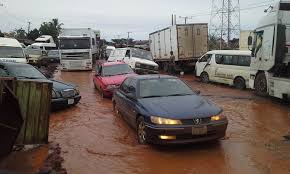An unmotorable Federal road.
 Comrade Owei Lakemfa.
Comrade Owei Lakemfa.
By Owei Lakemfa.
NIGERIA will be 60 on October 1. In the last two decades that we finally returned to civil rule after a cumulative 29-year military dictatorship, successive governments have made claims of developing infrastructure, particularly roads. Indeed, the state of our roads have been so bad that individuals and communities are forced to build their own roads.

In some cases, state governments, tired of waiting for the Federal Government to build its claimed roads, have had to construct a few of these roads. Despite these, coupled with the fact that less than 17 per-cent of our roads are paved, successive governments swallow huge sums of our annual budgets in the name of road construction and rehabilitation. For instance, in the name of highway projects, the Federal Government in 2013, paid out N459,531,567,360.57 to contractors. The following year, it paid contractors N532,816,907, 747.26. In 2015, contractors were paid N601,698, 875,536.00. In 2016, government paid contractors N681,004,177,246.37 and in 2017, N789,633,595,842.44.
I look at these huge sums paid out, see beautiful photographs of constructed roads but hardly know any of these highways fully completed. Even when I travel, what I see are billboards announcing on-going road construction and in most cases, abandoned road works. For instance, the Lagos-Badagry Expressway which leads to Benin Republic has been under reconstruction since 2010 with parts becoming impassable. There is a slightly comical angle to that side of the country: the dual Badagry-Sokoto Highway has been under construction since the early 1980s era of President Shehu Shagari. It has defied President Buhari’s first journey to power as Military Head of State in 1984/85, seen the backs of the Babangida, Shonekan, Abacha and Abdulsalami regimes, remained abandoned in the Obasanjo, Yar’Adua, Jonathan administrations and remains so in the Buhari administration. This abandoned road leads rudely into the bush. A sort of road to nowhere.
The repairs and part reconstruction of the 117-kilometre Lagos-Ibadan Expressway which began during the Obasanjo administration, has spanned the Yar’ Adua, Jonathan and Buhari administrations, yet remains uncompleted. The Ibadan-Oyo-Ogbomosho-Ilorin dualisation has been under construction since the inglorious days of military juntas. The Gombe-Larmode-Numan-Yola road project which the Buhari administration announced will reduce the travelling distance by 65 per-cent, aid the movement of farm produce and improve the living standard of people in that region, is still being constructed. The fate of the Ngurore-Jada-Garkida Road, where former Vice President Atiku Abubakar comes from, is in a similar state. The Yola-Hong-Mubi Road rehabilitation has also entered voice mail. The Lambatta-Lapai-Bida expansion and dualisation project is still in the works.
The prayer is that one day, the Kano-Maiduguri Road linking Jigawa, Bauchi, Yobe and Borno states which began in the era of General Ibrahim Badamosi Babangida, will be completed. The same prayer for the Kano-Katsina Road. In Babangida’s home Niger State, is Kontagora which hosts an important military base; the Sokoto-Koko-Birni-Yauri –Kontagora Road rehabilitation remains uncompleted. We cannot strictly blame or credit the Federal Government over the Bida-Mokwa Road construction because it is a World Bank project.
The 162-kilometre Abuja-Lokoja Express Way expansion which began two decades ago, remains uncompleted with the contract sum reviewed upwards from N42 billion to N116 billion. The Okene-Auchi-Benin dualisation which has spanned a number of years, seems to be under perpetual construction despite its being handled by the Chinese CCCEC, the Israeli RCC, Mothercat and Dantata. Another road artery that began during the Jonathan administration is the Ewu-Uromi- Agbor Road that is expected to terminate in Sapele. The Setraco construction company signs are usually visible on this road.
In the East, another major highway that seems to be under perpetual rehabilitation is the Enugu-Port Harcourt Road which began under the Obasanjo administration. That government departed over a dozen years ago. Another such road that has been battling with dualisation is the Onitsha-Enugu Road. The 657–kilometre East-West road from Warri to Calabar has been under construction since 2006 despite the upward review of the contract from N211 billion to N726 billion.
The Obasanjo-Yar’Adua-Jonathan administrations tried to wrap up major road constructions in Abuja. They completed the major dualisation of long highways like the those of Kubwa and Airport. The Buhari government made a show of continuing with such spirit. It took the comparatively tiny Dutse Road dualisation project, succeeded in completing one part, dug out the other part and abandoned it with attendant dust in which all vehicles and commuters are bathed daily. Yet the state of this road is far better than the tinier Ushafa-Bwari dualisation project. It was a sweet road and commuters must have been elated it was being transformed into a dual carriage way. The contractors moved to site promptly breaking parts of the old road in order to expand it. Earth was moved and the heavy equipment of the contractors damaged many parts of the road making them almost impassable. But commuters were hopeful this was for the good of all. Then the contractors disappeared with their equipment, and have not been seen until today. Meanwhile, the old Ushafa-Bwari Road which should have served as an alternative, has been abandoned since the Jonathan era.
The First Niger Bridge spanning Asaba and Onitsha was built by the French company, Dumez from 1964-1965. The Second Niger Bridge from Asaba through the Ozubulu and Ogbaru areas, a 1.634 kilometre stretch costing $653 million, was conceived by the Jonathan administration and the Buhari government reports it has pushed it to a near 40 per-cent completion. This is good news. The other news which is not good is that the Makurdi Bridge rehabilitation has been abandoned.
Still talking bridges, there is the good news that the twin 2.2 kilometre Loko-Oweto Bridge started under the Jonathan administration has now been completed at a revised cost of N51 billion. The sad news is that the bridge which can reduce the travelling duration between the North Central, South East and South-South by three hours, has no access roads, or they are yet to be built. It is literally a bridge to nowhere. This reminds me of the bridge built across the San Gabriel River, Azusa, California in 1936. The connecting East Fork Road expected to connect it was still under construction when it was washed away in the March 1-2,1938 floods leaving the bridge like a lonely orphan in the Sheep Mountain Wilderness. Today, the bridge is used for Bungee Jumping.
Road is a fundamental human right because you cannot exercise your freedom of movement if there are no roads that connect places and people. By the time the Buhari government leaves in 2023, the prayer is that the actual completion of major roads and bridges would be part of its verifiable achievements. So Help Us God!




GIPHY App Key not set. Please check settings